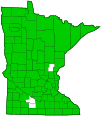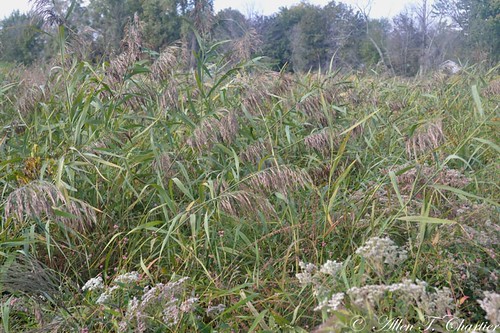common reed
(Phragmites australis)
Overview • Description • Distribution • Taxonomy
There are four generally recognized subspecies of Phragmites australis, three of which occur in North America. Two are native, one has been introduced and is now widely naturalized. Common reed is an important species for wetland ecosystems, providing habitat and food for a variety of organisms, including birds, insects, and fish. It also has a role in stabilizing wetland soils and preventing erosion. However, in some areas, its has become invasive. It grows in dense stands that can outcompete native plant species, reducing biodiversity and altering wetland ecosystems. Once established, it can be difficult to eradicate. |
||
Description |
||
Common reed is a 3½″ to 16½″ (1 to 5 m) tall, aquatic or semi-aquatic plant. Though called a reed, it is acutally a grass. The root system is extensive and can be up to 9¾′ (3 m) deep. The stem is erect, hollow, unbranched, round in cross section, and 3⁄16″ to ⅝″ (5 to 15 mm) thick. The leaves are linear to lance-linear, flat, drooping, 8″ to 24″ (20 to 60 cm) long, and 5⁄16″ to 1¼″ (8 to 32 mm) wide. The inflorescence is a single, large, dense, plume-like cluster of flowers at the end of the stem. Each flower is pruplish-brown and about ⅜″ (1 cm) in length. Each plant produces 1,500 to 2,000 seeds. |
||
Distribution |
||||
|
Sources |
|||
| 4/1/2023 | ||||
Taxonomy |
|||
| Kingdom | Plantae (Plants) | ||
| Division | Tracheophyta (Vascular Plants) | ||
| Subdivision | Spermatophytina (Seed Plants) | ||
| Class | Liliopsida (Monocots) | ||
Order |
Poales (grasses, sedges, cattails, and allies) | ||
Family |
Poaceae (grasses) | ||
| No Rank | PACMAD clade | ||
| Subfamily | Arundinoideae (reeds, giant canes, and allies) | ||
| Tribe | Molinieae | ||
| Subtribe | Moliniinae | ||
Genus |
Phragmites (common reeds) | ||
Subordinate Taxa |
|||
American common reed (Phragmites australis ssp. americanus) Eurasian common reed (Phragmites australis ssp. altissimus) European common reed (Phragmites australis ssp. australis) Subtropical common reed (Phragmites australis ssp. berlandieri) |
|||
Synonyms |
|||
Arundo altissima Arundo australis Arundo graeca Arundo isiaca Arundo maxima Arundo occidentalis Arundo palustris Arundo phragmites Arundo vulgaris Cynodon phragmites Oxyanthe phragmites Phragmites altissimus Phragmites australis ssp. maximus Phragmites australis var. berlandieri Phragmites berlandieri Phragmites capensis Phragmites caudatus Phragmites chilensis Phragmites communis ssp. berlandieri Phragmites communis ssp. maximus Phragmites communis var. berlandieri Phragmites communis var. flavescens Phragmites communis var. genuinus Phragmites communis var. hispanicus Phragmites communis var. isiacus Phragmites communis var. mauritianus Phragmites communis var. variegatus Phragmites communis Phragmites dioicus Phragmites fissifolius Phragmites hispanicus Phragmites isiacus Phragmites martinicensis Phragmites mauritianus Phragmites maximus Phragmites maximus var. berlandieri Phragmites maximus var. variegatus Phragmites occidentalis Phragmites phragmites Phragmites vulgaris Phragmites vulgaris ssp. maximus Phragmites vulgaris var. mauritianus Reimaria diffusa Trichoon phragmites |
|||
Common Names |
|||
common reed |
|||
Visitor Photos |
|||||
Share your photo of this plant. |
|||||
| This button not working for you? Simply email us at info@MinnesotaSeasons.com. Attach one or more photos and, if you like, a caption. |
|||||
|
|||||
MinnesotaSeasons.com Photos |
|||||
|
|||||

Visitor Videos |
|||
Share your video of this plant. |
|||
| This button not working for you? Simply email us at info@MinnesotaSeasons.com. Attach a video, a YouTube link, or a cloud storage link. |
|||
Other Videos |
|||
| common reed (Phragmites australis) UFInvasivePlantsEDU |
|||
About
Uploaded on May 24, 2010 Aquatic and Invasive Plant Identification Series by the UF/IFAS Center for Aquatic and Invasive Plants ( http://plants.ifas.ufl.edu ) and the Florida Fish and Wildlife Commission, Invasive Plant Management Section. For more information about common reed, go to http://plants.ifas.ufl.edu/node/323 Video editor/videographer - Phil Chiocchio |
|||
| The Common Reed, Phragmites with Tim Simmons Danger in the Reeds |
|||
About
Published on Feb 11, 2014 Viewers who may never have the opportunity to visit the Great Marsh will quickly understand from Tim's clear and precise explanations why these 14 square miles of marsh lands are so important to all of us and how Phragmites has evolved into a "super" species capable of damaging ecosystems like the Great Marsh wherever it is allowed to expand. |
|||

Visitor Sightings |
|||||
Report a sighting of this plant. |
|||||
| This button not working for you? Simply email us at info@MinnesotaSeasons.com. Be sure to include a location. |
|||||
|
|||||
MinnesotaSeasons.com Sightings |
|||||

|
Created: Last Updated: © MinnesotaSeasons.com. All rights reserved. |



